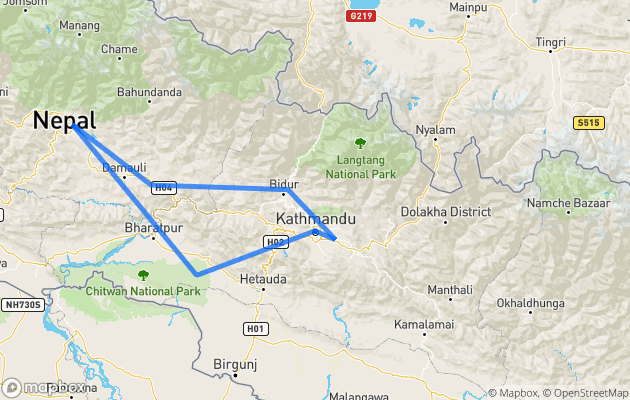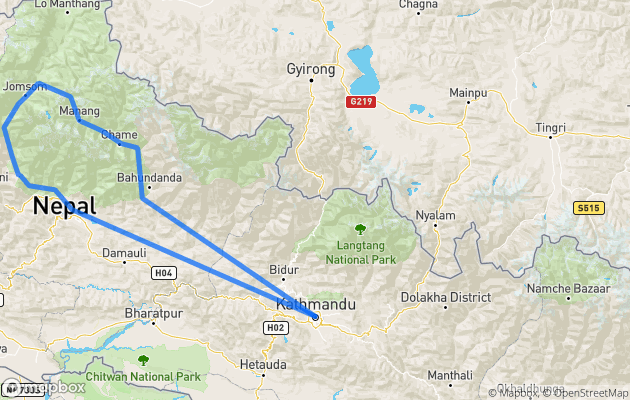Nepal Suggested Itineraries
Suggested Itineraries for Nepal - On Your Own
Not sure where to go? Try one of these common itineraries to take on your own, or mix and match destinations to plan your own independent trip.
1. Cultural Nepal
Approximate Time: 2 to 3 Weeks

Kathmandu - Bhaktapur - Nuwakot - Bandīpur - Pokhara - Royal Chitwan National Park - Kathmandu
Most people visit Nepal for the stunning backdrop of the Himalayas. The country is a mecca for hikers, but it also offers a rich culture and some impressive cities that are worth exploring. Depending on your trip length, you have a variety of options available to you. There are treks that last anywhere from a couple of days to a month or more. You must decide if you want to explore Nepal on foot through a lengthy trek, or visit more of the cultural sights. There are also many different adventure activities available to visitors. You can try your hand at everything from rafting to hang gliding or kayaking. Do some research in advance to decide what activities appeal to you the most.Whatever your purpose for visiting Nepal, you'll likely begin your trip in Kathmandu. Give yourself at least a few days to explore the city itself. If you need to stock up on some cheap hiking gear, head to the Thamel neighborhood to buy suppliers. If you're planning on doing some long hikes, you may also need to purchase permits in Kathmandu after you arrive.
From Kathmandu, head to Bhaktapur, which isn't far away, to spend the day. This is an ancient town that truly feels like you've stepped back in time. It has numerous heritage buildings, cobblestone streets, shrines, and car-free zones. It's a wonderful place to wander around. After that, spend another couple of days wandering around Nuwakot. Nuwakot provides wonderful views of the mountains. It also has a great bazaar and farmland that is lined with organic fields and terraced hillsides. Continue on to Bandipur, with its narrow streets and traditional wooden houses. After that, head to Nepal's second largest city, Pokhara. This city sits in a beautiful valley and is also the gateway to the Annapurna Region. It sits on the banks of a pleasant lake and offers a variety of day trips worth doing. After a couple of days exploring Pokhara, make your way to Chitwan National Park. This is a popular stop off for visitors to Nepal. It is home to tigers, one-horned rhinos, leopards and more. The park itself covers hundreds of square kilometers and includes a variety of habitats such as forests, grasslands, and flood plains. After Chitwan National Park, make your way back to Kathmandu to relax and catch your flight home.
2. The Annapurna Circuit
Approximate Time: 3 to 4 Weeks

Kathmandu - Bhulbhule - Bagarchhap - Chame - Pisang - Manang - Thorang Phedee - MuktinÄÂth - Kagbeni - Jomsom - Marpha - Lete - Tatopani - Poon Hill - Ghorepani - Tikhedhunga - Nayapul - Pokhara - Kathmandu
If you're traveling to Nepal to participate in a lengthy trek, then the Annapurna Circuit may be a good option for you. This is a multi-week trek that lasts about three weeks and is moderately intense in nature. If you complete the entire loop you'll begin with a gradual incline that increases over the first week or two. The trail's elevation maxes out at 5,416 meters or 17,769 feet, where it passes through Thorang La Pass. From there you'll begin the descent down. The first few days of the trail pass through beautiful, terraced rice paddies and lush agriculture. As the elevation climbs the vegetation thins out and the temperature drops. The climb also becomes more dramatic as it cuts into the edge of the mountain. The trail is relatively smooth though and absolutely no mountain climbing is required. As you begin your descent down the pass, you'll find the environment much drier and desert like. Several towns offer hot springs where hikers can rest their legs and relax for a few days.The Annapurna Circuit is one of the most popular trails in Nepal. For this reason you likely won't be alone during your hike. Part of the appeal of the trail is that it passes through quaint, small Nepalese towns. Hikers can stay in guesthouses along the trail and experience everyday Nepalese life. Some people choose to hire guides and porters for their hike, but this is not necessary. The trail is well marked, you will see plenty of hikers along the route, and it is generally safe to go it alone. Another option is to hire a porter and not a guide, but if you pack light and are in decent shape, then this is not required.
Most travelers fly into Kathmandu and then take a bus to Besisahar and on to Bhulbhule. From there the trek begins. There are many different towns along the route that you can stay in. Some popular stop off points include Chamje, Bagarchap, Chame, Upper Pisang, Manang, Letdar, and the high camp. Manang is a larger town and is a good place to spend a day or two while you acclimate to the higher altitude. It's also a good place to stock up on supplies. From there you cross the Thorang La Pass and begin the descent into Muktinath. From there you can go to Kagbeni, Jomsom, Marpha, Ghasa, Tatopani, Poon Hill, Ghorepani, Tikhedhunga, and Nayapul. Once you've finished the trail you can catch a bus to Pokhara where you can relax for several days and let your legs recover. It's easy to catch a bus back to Kathmandu from Pokhara.
 Budget Your Trip is all about finding out how much everything costs so that you can travel cheaper and longer. Created by avid travelers Laurie and Bryan, our goal is to help you plan your next trip on the right budget. With average daily travel costs that are calculated from the budgets of real travelers, plus an analysis of hotel and tour prices, you can find out how much money you need to plan your next adventure. We also have plenty of travel advice, accommodation reviews, and activity suggestions.
Budget Your Trip is all about finding out how much everything costs so that you can travel cheaper and longer. Created by avid travelers Laurie and Bryan, our goal is to help you plan your next trip on the right budget. With average daily travel costs that are calculated from the budgets of real travelers, plus an analysis of hotel and tour prices, you can find out how much money you need to plan your next adventure. We also have plenty of travel advice, accommodation reviews, and activity suggestions.
